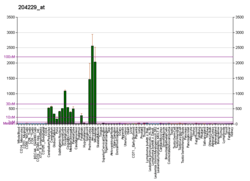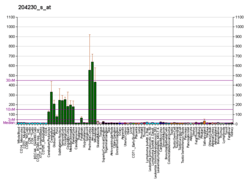Vesicular glutamate transporter 1
Vesicular glutamate transporter 1 (VGLUT1) is a protein that in humans is encoded by the SLC17A7 gene.[5][6][7]
The protein encoded by this gene is a vesicle-bound, sodium-dependent phosphate transporter that is specifically expressed in the neuron-rich regions of the brain. It is preferentially associated with the membranes of synaptic vesicles and functions in glutamate transport. The protein shares 82% identity with the differentiation-associated Na-dependent inorganic phosphate cotransporter and they appear to form a distinct class within the Na+/Pi cotransporter family.[7]
See also
References
- 1 2 3 GRCh38: Ensembl release 89: ENSG00000104888 - Ensembl, May 2017
- 1 2 3 GRCm38: Ensembl release 89: ENSMUSG00000070570 - Ensembl, May 2017
- ↑ "Human PubMed Reference:".
- ↑ "Mouse PubMed Reference:".
- ↑ Ni B, Du Y, Wu X, DeHoff BS, Rosteck PR Jr, Paul SM (Jul 1996). "Molecular cloning, expression, and chromosomal localization of a human brain-specific Na(+)-dependent inorganic phosphate cotransporter". J Neurochem. 66 (6): 2227–38. doi:10.1046/j.1471-4159.1996.66062227.x. PMID 8632143.
- ↑ Aihara Y, Mashima H, Onda H, Hisano S, Kasuya H, Hori T, Yamada S, Tomura H, Yamada Y, Inoue I, Kojima I, Takeda J (Jun 2000). "Molecular cloning of a novel brain-type Na(+)-dependent inorganic phosphate cotransporter". J Neurochem. 74 (6): 2622–5. doi:10.1046/j.1471-4159.2000.0742622.x. PMID 10820226.
- 1 2 "Entrez Gene: SLC17A7 solute carrier family 17 (sodium-dependent inorganic phosphate cotransporter), member 7".
Further reading
- Bellocchio EE, Reimer RJ, Fremeau RT, Edwards RH (2000). "Uptake of glutamate into synaptic vesicles by an inorganic phosphate transporter". Science. 289 (5481): 957–60. doi:10.1126/science.289.5481.957. PMID 10938000.
- Takamori S, Rhee JS, Rosenmund C, Jahn R (2000). "Identification of a vesicular glutamate transporter that defines a glutamatergic phenotype in neurons". Nature. 407 (6801): 189–94. doi:10.1038/35025070. PMID 11001057.
- Strausberg RL, Feingold EA, Grouse LH, et al. (2003). "Generation and initial analysis of more than 15,000 full-length human and mouse cDNA sequences". Proc. Natl. Acad. Sci. U.S.A. 99 (26): 16899–903. doi:10.1073/pnas.242603899. PMC 139241. PMID 12477932.
- Ota T, Suzuki Y, Nishikawa T, et al. (2004). "Complete sequencing and characterization of 21,243 full-length human cDNAs". Nat. Genet. 36 (1): 40–5. doi:10.1038/ng1285. PMID 14702039.
- Eastwood SL, Harrison PJ (2005). "Decreased expression of vesicular glutamate transporter 1 and complexin II mRNAs in schizophrenia: further evidence for a synaptic pathology affecting glutamate neurons". Schizophrenia Research. 73 (2–3): 159–72. doi:10.1016/j.schres.2004.05.010. PMID 15653259.
- Alonso-Nanclares L, De Felipe J (2005). "Vesicular glutamate transporter 1 immunostaining in the normal and epileptic human cerebral cortex". Neuroscience. 134 (1): 59–68. doi:10.1016/j.neuroscience.2005.03.038. PMID 15961236.
- Vinatier J, Herzog E, Plamont MA, et al. (2006). "Interaction between the vesicular glutamate transporter type 1 and endophilin A1, a protein essential for endocytosis". J. Neurochem. 97 (4): 1111–25. doi:10.1111/j.1471-4159.2006.03821.x. PMID 16606361.
- Almqvist J, Huang Y, Laaksonen A, et al. (2007). "Docking and homology modeling explain inhibition of the human vesicular glutamate transporters". Protein Sci. 16 (9): 1819–29. doi:10.1110/ps.072944707. PMC 2206968. PMID 17660252.
This article incorporates text from the United States National Library of Medicine, which is in the public domain.
This article is issued from
Wikipedia.
The text is licensed under Creative Commons - Attribution - Sharealike.
Additional terms may apply for the media files.





